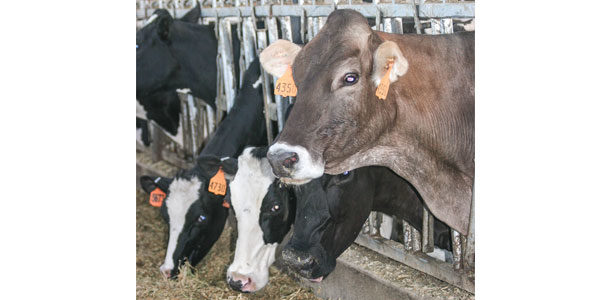Traditionally, a “steam-up” dietary approach was used in dry cows to provide additional energy in the form of fermentable carbohydrate when dry matter intake typically declined before calving by up to 30 percent. Also, the additional energy was thought to ease the transition to the higher-energy, more fermentable lactating diet.
However, this dietary approach frequently led to transition failures since cows were overconditioned at calving or metabolically acted that way and then had excessive bodyweight loss and a greater incidence of metabolic disorders, such as fatty liver and ketosis, in early lactation.
Currently, lower-energy (controlled-energy) dry cow diets are recommended for use in one- or two-group management systems. The goal is to provide sufficient energy to meet daily needs while not supplying excessive energy intake relative to requirements.
The dietary recommendations are based on two decades of research that has characterized the metabolic adaptations that occur in the liver, fat, muscle and mammary gland.
Although the benefits for controlled-energy dry diets are well-established, there is concern that a rapid change from a lower-fermentable carbohydrate dry diet to a higher-fermentable carbohydrate lactating diet may make cows more susceptible to digestive disorders such as subacute ruminal acidosis (SARA).
Surprisingly, relatively little is known about how rumen papillae adapt during the transition period.
Classic research from the 1980s indicated it can take four to eight weeks for maximum papillae growth to occur when cows were fed extremely low-energy, high-forage diets followed by high-energy, high-grain diets.
This research drove the recommendation in the 1990s and early 2000s that close-up dry diets should be intermediate in carbohydrate fermentability and energy between the far-off dry diet and the lactating diet to stimulate growth of the rumen epithelium to increase the surface area for volatile fatty acid absorption and prevent low rumen pH (i.e., SARA).
More recently, Canadian researchers suggested that with today’s far-off dry cow feeding strategies, the regression of the rumen papillae is only moderate with absorptive surface of the papillae only regressing to 75 percent of that present during lactation.
Also, the surface area is restored within two to three weeks with close-up dry diets. However, there is some evidence that fresh cows still experience SARA, in part due to the decrease in dry matter intake that occurs at calving and its negative impact on rumen epithelial function. Rumen epithelial function might be more important than papillae surface area.
Another group of Canadian researchers fed cows a controlled-energy dry diet followed by a higher-energy diet after calving and took samples of rumen papillae at minus three, plus one and plus six weeks relative to calving. Interestingly, the rumen papillae underwent histological, morphological and transcriptomic adaptations in early lactation.
These adaptations occurred in response to growth factors that changed gene expression patterns and influenced the epithelial structure. The researchers noted that understanding the mechanism of rumen epithelial tissue growth and differentiation may lead to novel nutritional strategies, feed additives or bioactive ingredients.
Butyrate, a volatile fatty acid from rumen fermentation, is known to stimulate rumen epithelial proliferation and papillae growth which increases surface area for nutrient absorption.
Thus, Polish researchers evaluated recently a microencapsulated sodium butyrate product (zero or 300 g per day) in the close-up dry diet of cows for 30 days to potentially enhance rumen papillae growth and rumen adaptation to the lactation diet.
After calving, cows were fed a lactating diet without sodium butyrate for 60 days. Interestingly, cows fed sodium butyrate had approximately 1.7 kilograms more dry matter intake during the last five days before calving compared with the control cows without increasing plasma betahydroxybutryate. Unfortunately, there was no effect of sodium butyrate supplementation on dry matter intake or milk yield in early lactation.
Until we understand more about the adaption of rumen papillae, proper dietary formulation and good feed bunk management will continue to be critical for the prevention of ruminal acidosis in our fresh cows.
The risk of SARA can be minimized by proper formulation of diets to optimize intake of fermentable carbohydrate, intake of physically effective fibre and endogenous buffering capacity; minimizing the depression of dry matter intake as calving approaches; consistent delivery of diets with minimal variation in composition; continuous access to feed so meals are small and regular and thus avoiding slug feeding; and inclusion of appropriate feed additives that prevent low ruminal pH. PD
References omitted due to space but are available upon request. Click here to email an editor.
—Excerpts from the Miner Institute Farm Report, April 2015
PHOTO: Canadian researchers suggested that with today’s far-off dry cow feeding strategies, the regression of the rumen papillae is only moderate with absorptive surface of the papillae only regressing to 75 percent of that present during lactation. Photo by Emily Caldwell.

-
Heather Dann
- Research Scientist
- Miner Institute
- Email Heather Dann











